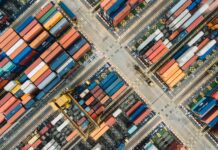
The investment for the APM Terminals MedPort Tangier expansion is in line with APM Terminals’ global commitment to achieve a 70% reduction in absolute emissions by 2030 and net zero emissions by 2040.
More specifically, the expansion phases will use all-electric or hybrid terminal equipment, automated mooring technology and potential shore power.
Within three years of its inauguration, APM Terminals MedPort Tangier, an automated transshipment terminal, has managed to become one of the most technologically advanced terminals in Africa.
The terminal has two phases of expansion planned. The second phase of development began in April 2021 and is expected to be fully operational in the first quarter of 2024, while the third phase is scheduled to be operational in the first quarter of 2025.
It is noteworthy that in total, the investment will increase the capacity by more than 2.1 million TEU.
The new equipment will consist of, among others, eight electric ship-to-shore cranes and 28 electric automated rail mounted gantry cranes.
Moreover, a fleet of 23 new semi-automatic hybrid shuttle carriers from Kalmar and its hybrid AutoStrad solution will ensure high productivity and further support reduced CO2 emissions.
Finally, the terminal will install an auto-mooring system, provided by Cavotec. This system will reduce the time it takes for vessels to moor and release.
According to Cavotec, the system can reduce direct emissions during ship docking by more than 90% due to the reduced use of tugs and ship engines.
However, the company also works on land to achieve its goals.
Together with the port authority, it is conducting a feasibility study for the supply of shore power. When ships use shore-based electricity, they connect to landside electricity for their berthing power needs instead of using auxiliary diesel engines, which can reduce overall emissions by up to 98%.
“We are constantly on the lookout for new ways to increase operational and energy efficiencies and reduce the climate impacts of our terminals,” said Sahar Rashidbeigi, head of decarbonisation at APM Terminals.
“Pushing boundaries and exploring new technology will help us achieve not only our own net-zero-emissions goals but also support our customers and the broader maritime industry in decarbonizing their respective operations,” she added.





